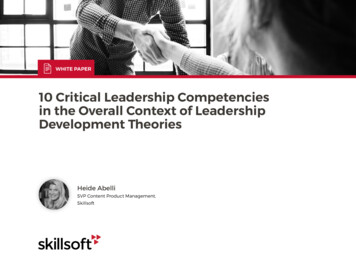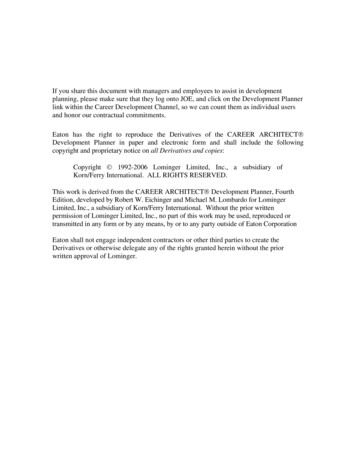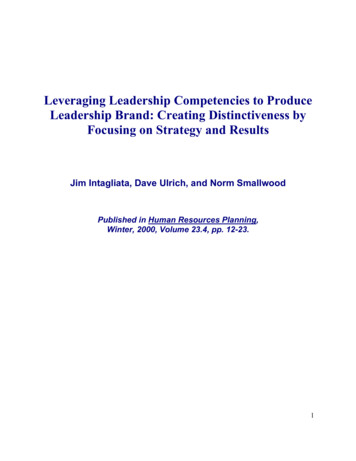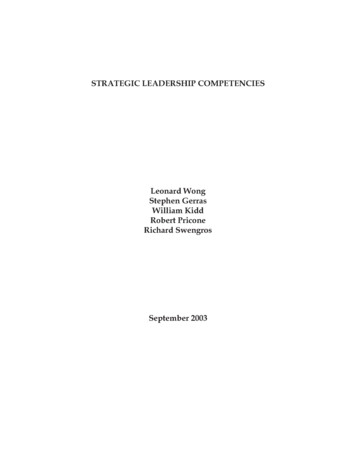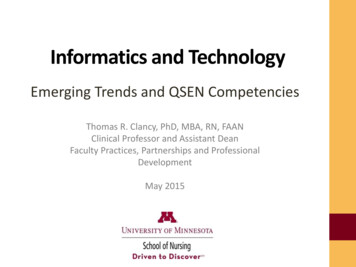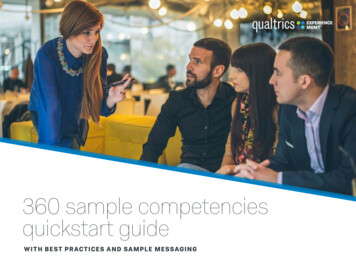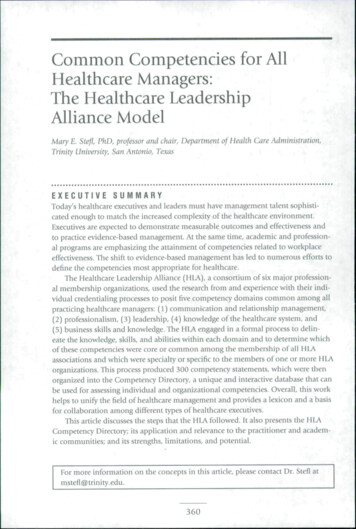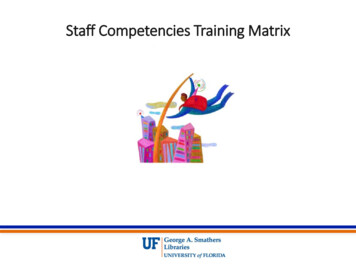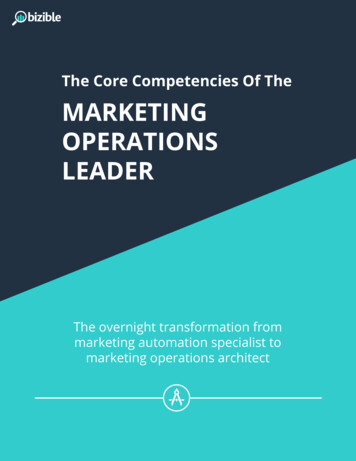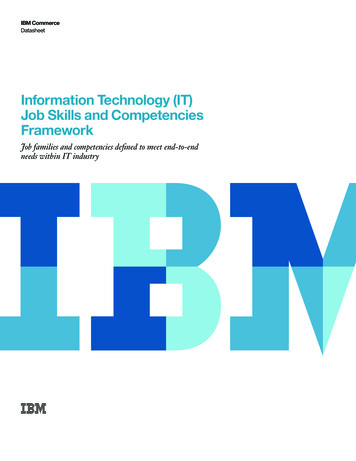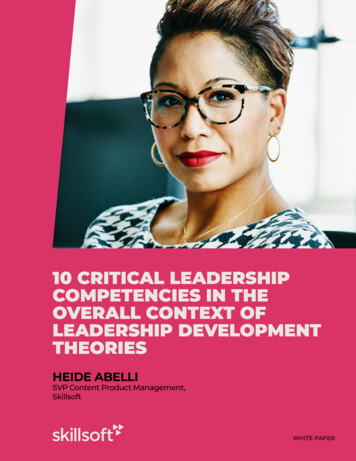
Transcription
10 CRITICAL LEADERSHIPCOMPETENCIES IN THEOVERALL CONTEXT OFLEADERSHIP DEVELOPMENTTHEORIESHEIDE ABELLISVP Content Product Management,SkillsoftWHITE PAPER
EXECUTIVESUMMARYLeadership as a discipline has been widely studied for a long period of time. Many theoriesof leadership have emerged, each with its own attempt to help us better understand anddevelop leadership capability.The six main categories of theories include trait, behavioral, power and influence, situation,charismatic, and transformational. This paper discusses each category in turn, thenSkillsoft’s modern, evidence-based approach to leadership development and “the 10critical SLDP competencies.”10 CRITICAL LEADERSHIP COMPETENCIES IN THE OVERALL CONTEXT OF LEADERSHIP DEVELOPMENT THEORIES2
CATEGORIESOF LEADERSHIPTHEORYTRAITThe trait approach to leadership emphasizes the personal traits of leaders. The underlyingassumption is that certain people possess innate characteristics that make them better leadersthan others. Theories included in the trait approach include the “Great Man” theory ofleadership, Stogdill’s leadership traits, and the theories espoused by Maccoby, John Gardnerand Jim Collins.BEHAVIORALThe behavioral approach switched the emphasis to observations of what effective andineffective leaders do on the job, so this approach takes a more pragmatic applicationapproach. Theories included in the behavioral approach include Mintzberg’s 10 managerialroles, Kotter’s leadership factor, Stewart’s three-part theory of management, Kouzesand Posner’s leadership challenge and Ulrich and Zenger’s Results-Based Leadership.POWER AND INFLUENCEThe power and influence approach studies the influence processes at work between leadersand other individuals, including those they lead. The theories included in the power andinfluence approach include “the two faces of power,” Winter’s theory of leadership, The WestPoint Way of leadership, social exchange theory, and the strategic contingencies theory.SITUATIONALThe situational approach pays attention to the contextual factors and asks the question of howthe larger contextual situation affects the leadership task by examining the nature of the workperformed by leader and team, the individual characteristics of members of the team, etc.Theories included in this approach are Blanchard’s situational theory of leadership, House’spath-goal theory of leadership, Fiedler’s contingency model, Leadership substitutes theory,the multiple-linkage model, and the cognitive resources theory.10 CRITICAL LEADERSHIP COMPETENCIES IN THE OVERALL CONTEXT OF LEADERSHIP DEVELOPMENT THEORIES3
CHARISMATICThe charismatic approach to leadership studies followers’ perceptions of the leader’s traitsand behaviors, the situational context and the needs of the followers. Theories included in thisapproach are House’s theory of charismatic leadership, attribution theory of charisma, andthe self-concept theory.TRANSFORMATIONALFinally, the transformational approach is viewed as a process by which leaders and their directreports inspire each other to elevate moral conduct. The Warren Bennis theory of leadership,James Macgregor Burns’ theory of leadership, Bass’ theory of transformational leadership,Tichy and Devanna’s transformational leadership process and Schein’s model oforganizational culture and leadership are all included in this approach.10 CRITICAL LEADERSHIP COMPETENCIES IN THE OVERALL CONTEXT OF LEADERSHIP DEVELOPMENT THEORIES4
THE SKILLSOFTAPPROACH TO LEADERSHIPDEVELOPMENTWhile each of these approaches and each of the theories within an approach has merit.Skillsoft prefers not to design a leadership program around a single idiosyncratic leadershiptheory. However, the approach taken comes closest to the behavioral approach and includesaspects of the trait approach. There is a major emphasis on developing competencies andmindsets that facilitate collaborative and collective leadership practices. These practices arethe lynchpin for effective leadership in the digital economy where team members can rise,at any given time, to the top when their particular skills or expertise are needed to boost thelevels of creativity, agility, innovation and speed of decision making. Collaborative leadershipdraws upon the notion of “servant” leadership but with service to the team and collectiveleadership relies upon the self-organizing of teams to solve problems more quickly in anenvironment of uncertainty and complexity.Instead of narrowly developing the program to reflect only the specific theories of Mintzberg,Zenger, Kotter, Posner or others, The Skillsoft Leadership Development Program espouses10 critical evidence-based behavioral competencies in an overall portfolio of 30 modernleadership development competencies. Skillsoft uses an evidence-based approach to arrive atthe set of competencies and, more importantly, the design and instructional strategies usedin the program to make sure that the content is effective.The 10 “critical” leadership competencies are based on the results of a sub-set ofwell-executed and highly regarded studies from both industry and academia, ranging fromThe Five Practices of Exemplary Leadership espoused in LPI to Google’s rigorous ProjectOxygen research which informed the discussion of critical management and leadershipcompetencies. The eight attributes that Google found in their original Project Oxygenresearch provide a comprehensive (although incomplete) picture of the essential elementsof effective management / leadership. Below is the list of the eight competencies resultingfrom Google’s Project Oxygen work.Since the original research concluded, Google subsequently added two additionalcompetencies: diversity / inclusion and collaboration. Google included these additionalcompetencies as a result of the work that specifically highlights the importance ofpsychological safety in teams, research on diversity and inclusion, and the importanceof establishing very clear performance expectations.10 CRITICAL LEADERSHIP COMPETENCIES IN THE OVERALL CONTEXT OF LEADERSHIP DEVELOPMENT THEORIES5
It is important to highlight that the attributes for improving manager / leadereffectiveness rest on a number of evidence-based assumptions. These assumptions includethe following:1.Management consists of a set of describable, articulable behaviors.2. These behaviors are broadly applicable to diverse functional groups andto differing nationalities and cultures with only minor adaptation, if at all.3. Managers can become more effective at these behaviors through acombination of feedback, training & development, reflection, and practice.GOOGLE’SPROJECT OXYGEN:DO MANAGERS/LEADERS REALLYMATTER? 4. Effective management is as much about developing people as it is aboutgetting the work done.5. Effective management is more about raising the employees’ level ofaccomplishment than removing sub-par performers or limiting dysfunctionalbehaviors. These assumptions are heavily supported by research.A number of scholars have studied managers operating in the workplace and havedescribed, at a highly granular level, the actions, interactions, and behaviors they haveobserved. Scholars have noted the existence of common behaviors across diversefunctions, positions and cultures. Studies have shown that people can learn and improvetheir management and leadership competencies through a combination of feedback,reflection, training & development and practice. Organizational scholars have long arguedthat developing people and creating deep bonds with employees are among the mostimportant responsibilities of managers and leaders at companies seeking high performance.The eight attributes from Project Oxygen rest on a firm foundation of rigorous research.Widespread adoption of the eight attributes at Google led to quantifiable improvementsin management effectiveness, raising manager “favorable scores” across all categories andgeographies. Improvement was most dramatic among the least effective managers,who are often the source of deep employee dissatisfaction.The results of the Project Oxygen study, together with well-researched studies done byMcKinsey, Gallup, and a team of academics at Harvard Business School (including recentwork on effective teaming by Amy Edmondson) and several other studies (Gallup, etc.)all provide the theoretical and evidence-based selection of the 10 critical competencies.These 10 constitute a third of the total competencies we have developed as part of ourSkillsoft Leadership Development Program (SLDP.) These 10 competencies arehighlighted in the chart on the following page.1 Multi-yearresearch projectEight KeyManagementAttributes, broadlyconsistent withacademic researchon managerial andleader behavior andeffectiveness.Be a good coachEmpower the teamExpress concernfor team members’success andwell-beingBe productive andresults-orientedBe a goodcommunicatorHelp with careerdevelopmentHave a visionUse your technicalskills to advise1“Google’s Project Oxygen: Do Managers Matter?” David A. Garvin, Alison Berkley Wagonfeld and Liz Kin.Harvard Business School Case Study.10 CRITICAL LEADERSHIP COMPETENCIES IN THE OVERALL CONTEXT OF LEADERSHIP DEVELOPMENT THEORIES6
THE SKILLSOFT LEADERSHIPDEVELOPMENT PROGRAMLEADERSHIP DEVELOPMENT TOPICSCoachingInfluence andPersuasionNew LeaderTransitionsBuildingand LeadingSuccessful TeamsThe AccountableLeaderLeading Throughthe Challengeof ChangeCreating aSuccessful BusinessExecution CultureDevelopingPeopleLeading withValuesand EthicsThe ng withExecutivePresenceLeading withMindfulnessEmbracingDiversity in YourLeadershipLeading withDigitalTechnologyCritical Thinkingand CognitiveFlexibilitySetting andManagingPrioritiesLeadingAcrossCulturesProblem Solvingand DecisionMakingCoordinatingwith YourLeader PeersLeadingThroughDisruptionLeading aCustomer-CentricCultureJudgment andDecisivenessThe Agile Leader:Perseveranceand gConflictWomen inLeadershipSample Leading Throughthe Challenge of ChangeCourse: Leader MentorSample Agile Leader Course:Host as Learning Agent10 CRITICAL LEADERSHIP COMPETENCIES IN THE OVERALL CONTEXT OF LEADERSHIP DEVELOPMENT THEORIES7
Descriptions of foundational video-based courses covering the 10 critical competencies are below:FOUNDATIONAL VIDEO-BASED COURSESCOVERING THE 10 CRITICAL COMPETENCIESBuilding and LeadingSuccessful TeamsTeamwork is essential to successful business practice. Permanent or temporary,workgroups need to function efficiently and effectively. In this course, you’ll learnhow to construct and lead teams, while avoiding and mitigating dysfunction.Creating aSuccessful BusinessExecution CultureLeaders must execute the strategies they help create. Without execution, a strategy isjust an idea. In this course, you’ll learn how to build and lead an “execution culture”that empowers employees to translate strategy into action.Becoming anEmotionallyIntelligent LeaderBuilding emotional intelligence can help you make better decisions and improve yourbusiness relationships. In this course, you’ll learn skills and behaviors to developyour emotional competency and become a more mindful and capable leader.DevelopingSuccessful CoachingRelationshipsLeaders must support a culture conducive to coaching and be capable of steppinginto a coaching role at any time. In this course, you’ll learn how to build dynamic andpurposeful coaching relationships.Leading throughProblem Solving andDecision MakingThe hallmark of leadership is being able to work through problems and make toughdecisions using the skills and experience of your team. In this course, you’ll learnhow to use a three-stage approach to engage your team in this effort.The Agile LeaderEven a small shift in direction can accelerate success. In this course, you will learnhow to adopt a focused and flexible mindset; respond quickly with adaptivetechniques; and empower others to reach goals.AccountableLeadershipAccountability is about taking ownership of your own actions, and it is key to yourorganization’s success. In this course, you’ll learn how to foster and determineaccountability, in your workplace, your team, and yourself.Leading byDeveloping PeopleGood leaders promote development so that everyone can reach their highest potential.In this course, you’ll explore myths and challenges of development and learn waysto encourage, perform, and set standards for development of others.Leading DiversityDiversity is a fact of life and a source of great benefit in the modern marketplace andworkforce. In this course, you’ll learn skills to help you manage and leverage diversityfor the advantage of the organization.Leading throughShared VisionA powerful vision, clearly articulated, motivates people to take action and drivesbusiness results. In this course, you’ll learn how to create and communicate arealistic and actionable vision that inspires commitment from people.10 CRITICAL LEADERSHIP COMPETENCIES IN THE OVERALL CONTEXT OF LEADERSHIP DEVELOPMENT THEORIES8
IN SUMMARYThe set of 10 competencies represent a very thoughtful, evidence-based selection of thecritical competencies all individuals should seek to master for meaningful improvement inmanagement and leadership capability. We offer 30 competencies in our overall solution inorder to round out the development opportunities for managers and leaders across afuller range of competencies, especially those most critical for leading in the digital economy.However, if a learning and development professional seeks to mandate development againsta smaller set of competencies, these 10 are the ones that should be developed for the greatestpositive benefit to the organization.Click here to learn more about the Skillsoft Leadership Development Program.RECOMMENDED SOURCES“Google’s Project Oxygen: Do Managers Matter?” David A. Garvin, Alison Berkley Wagonfeld and
GOOGLE’S PROJECT OXYGEN: DO MANAGERS/ LEADERS REALLY MATTER? Multi-year research project Eight Key Management Attributes, broadly consistent with academic research on managerial and leader behavior and effectiveness. Be a good coach Empower the team Express concern for team members’ success and well-being Be productive and
